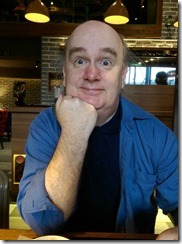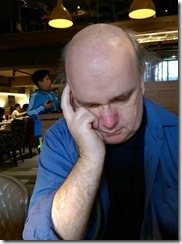How much caffeine in coffee does the Kirkland brand coffee actually have?
by Lantz from Minnesota
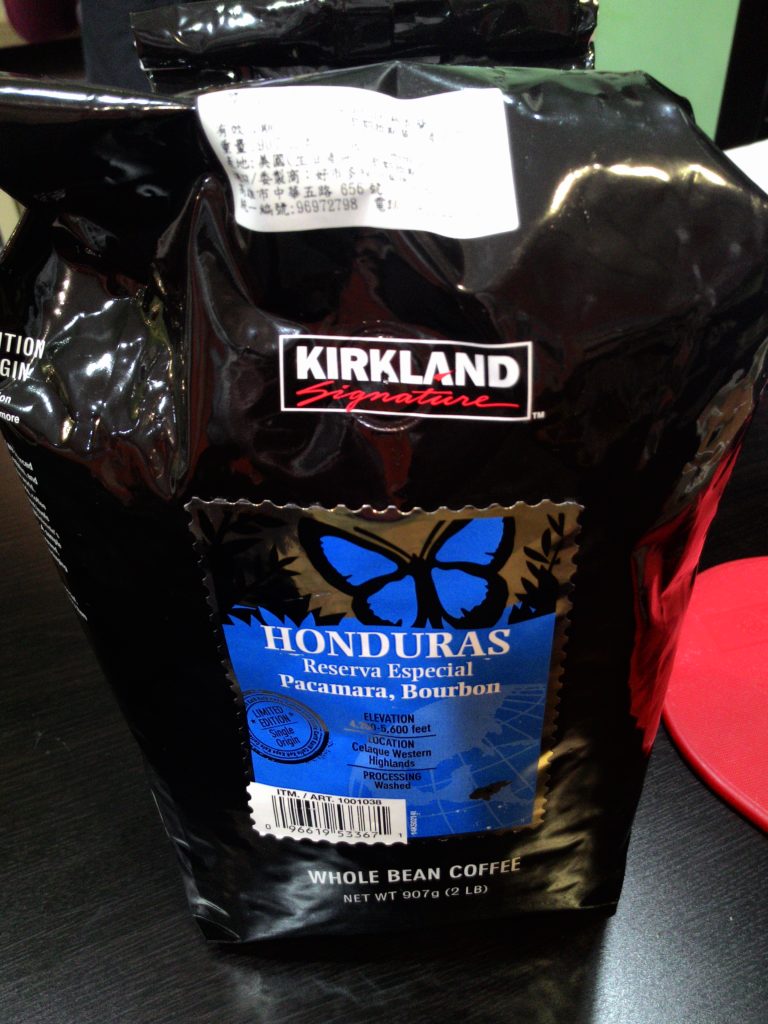
Sample Honduran Coffee: Caffeine in coffee level unknown
I’ve been buying Kirkland coffee for a while, and I was wondering: How much caffeine is in this Kirkland brand coffee? Thank you.
Lantz from Minnesota
—-
At PurelyCoffeeBeans, I’ve answered lots of questions over the years. You’ll find the questions and their answers scattered throughout the site! I’m always open to more questions, if you’re frustrated or curious, or you want to review a coffee, why don’t you drop me a line!
This week we welcome…!
—-
How much caffeine is that?
What Kirkland coffee is decaf?
How can I cut my caffeine?
More information about caffeine in coffee
- More reading about caffeine
- Comments & Replies
So how much caffeine in coffee does Kirkland brand coffee actually have?
Thank you for taking the time to contact me. Lantz. Let me see if I can help you out a little!
For those of you unfamiliar with Kirkland coffee, I suggest you read my article introducing quite a wide range of Kirkland coffee beans, first. Now, Lantz, I can only surmise that you’re worried about consuming too much caffeine in coffee. Without my caffeine, I feel that coffee is less interesting. Perhaps something goes missing along with the caffeine when it’s decaffeinated…
- Before Caffeine
- After Caffeine
I also received this comment from a reader regarding the caffeine content of Kirkland Coffee.
decaf coffee
by: d***@***.comKirkland seems to be evasive about its decaf coffee. What is the caffeine content in a 6 oz, cup of your 3 lb. can of decaf coffee.
While Kirkland doesn’t publish its caffeine content figures anywhere, it is reasonable to assume that their caffeine content is fairly standard, with a possible exception for the espresso. I believe that you’d be looking at about 150-200 mg of caffeine per 8oz cup. For their decaf coffee, it would be hard to guess but the FDA provides an estimate, depending on the processing, of between 2mg and 15mg per oz.
How much caffeine in coffee are you drinking?
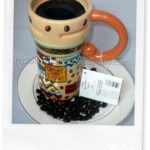
I think we can make some broad assumptions to get started in calculating the caffeine in coffee. Namely, the serving size, the type of coffee you’re drinking, and whether you’re consuming other sources of caffeine. You may not realize that caffeine in coffee is not your only dietary source of coffee! Let’s do our A, B, Cs of caffeine consumption!
A. How big is your cup of coffee? Really…
So how big is your drink serving? A standard Americano (Tall size) has about 12 fl.oz of coffee in it, and approx. 150mg of caffeine. But a Venti is double that, so the total caffeine is 300mg!
Most coffee shop drink sizes are listed below. sizes. Don’t be tricked by the names! Look at the volume!

Caffeine in coffee table of stats
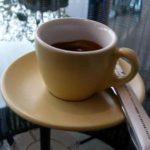
You can also determine the caffeine in a Cappuccino, Latte and other coffee drinks by simply multiplying the average caffeine in a shot (75mg) with the number of shots used to make your drink.
So if you’re downing several cups each day of 12 fl. oz (or typical mug size), you’ll be consuming about 300mg at the very least.
By comparison, the Italians may down an espresso or two during the day, but it’s likely to be a single shot. Even their cappuccinos are typically between 5 fl.oz and 7 fl.oz. So they may like their espresso, but they’re not consuming as much caffeine compared to a large or extra large coffee in one day!
B. How much coffee powder are you putting in your cup?
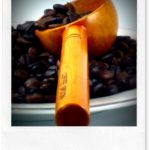
Now, a straightforward number may be more elusive than that. Why? How much ground coffee do you put into each cup?
I usually use between 1/2 oz (15g) to 3/4 (22g) oz per cup, but then my cups are a little bigger. I typically drink about 12 fl.oz in my morning coffee. I’m told that a typical Americano uses about 14-18g of coffee for a tall size.
You could be using more coffee than that, though, in your daily routine to make your coffee, especially if you prefer coffee with more body and flavor. At one point, I was brewing through Aeropress about 40g of coffee for my morning brew. It did feel a little bit too much, even by my standards!
What decaf Kirkland coffee can I find?
Since Lantz specifically asked about Kirkland coffee, I put together the three decaf coffee brands you might find in Costco and on Amazon below. I hope one of them works for you. Keep reading!
#1 – Kirkland Signature Medium Roast Decaf House Blend Coffee Review
If you’re counting your caffeine in coffee religiously, because you’re concerned with your daily caffeine intake. Take a look at Kirkland Signature Medium Roast Decaf House Blend (see Decaffeinated Coffee).
Though it’s getting hard to find in-store, you can still buy it in stores and on Amazon. Served in an identifiable blue bag, it is custom-roasted by Starbucks for Kirkland Coffee. Like most decaff coffee, there is likely to be still a small percentage of caffeine in the coffee.
Check Price on Amazon
Why we liked it!
- Rich flavor and body
- Not bitter or acidic
- Quality, consistent standard
- Very attractive price
Why we didn’t like it
- Taste lacking somewhat
- Some found it a tad acidic
#2 – Kirkland Signature 100% Colombian Dark Roast Decaffeinated Ground Coffee
Kirkland Signature 100% Colombian Decaff Dark Roast is a decaffeinated ground coffee that appeals to many coffee drinkers. Despite being a dark roast, it inspires customers with its low caffeine, solid flavor profile, and a very affordable drinkable alternative to premium decaffeinated coffees from other big brands.
Check Price on Amazon
Why we liked it!
- Highly recommended
- Rich, full taste that appeals
- Delicious dark roast
- Very attractive price
Why we didn’t like it
- Not as dark roast as some prefer
- It’s a large can of ground coffee, so drink it quickly!
#3 – Kirkland Signature House Decaf Coffee 120 K-Cup Pods
Finally, one for all you Keurig owners, a Kirkland Decaff House Blend K-Cup! Yes, Kirkland have made a top quality decaff K-Cup for all you caffeine-intolerant coffee lovers with Keurigs! The box contains 120 K-cups though bigger sizes offer better savings. Click on the link and look for 240-cup boxes or multi-buy purchases.
Check Price on Amazon
What we liked
- Kirkland’s famous house blend
- It’s a K-Cup
- Doesn’t taste like decaff!
- Competitive price/box
What we didn’t like
- Compared to ground coffee, more expensive
- Some prefer a bolder coffee
- Prefer other K-Cups
C. What coffee beans are you brewing? How are you brewing?
For other varieties of coffee, you’ll notice that there is a variety of levels of caffeine from bean to bean, roast to roast, and even method to method.
Some Arabica coffee beans and Robusta coffee beans vary from the typical levels. So if you’re drinking Robusta coffee (either mixed or pure), you’ll likely find that the coffee has more caffeine per fluid ounce of caffeine. It is typically added to give a little ‘kick’ and body to the final drink. But because of its bitterness, it can’t dominate the coffee content.
Italians love a touch of robusta mixed with their Arabica in espresso coffees, but you can also find it in Vietnamese coffee, and many cheaper (non-100% Arabica) coffee.
I’ve found several useful resources for caffeine in coffee:
Caffeine in Coffee from Center for Science in the Public Interest
and
Caffeine Content of Drinks (click on Coffee)
S. What other caffeine sources are there in your diet?
Do you prefer a lot or a little caffeine in your coffee? If you’re looking to cut down on your caffeine content, you should also look at the amount of soda, tea, sports drinks, and chocolate you consume each day. Then decide where to start by looking at what causes the problems. Is it too much of one or too much of all?
Chocolate, for example, creeps into many products that are popular like ice cream, breakfast cereal, and cakes. While caffeine can even be found in over-the-counter medications for flu & colds. Though caffeine in coffee may be your primary source, if you’re worried about your consumption of caffeine, it’s wise to look at all the possible sources.
How can you cut your caffeine in coffee?
You can adopt a number of strategies to cut your caffeine in coffee, if you decide that you need to cut your caffeine down.
i. Drink less coffee, less frequently
This may seem obvious, but instead of going teetotal. Switching a cup or two of coffee to another beverage with little or no caffeine is probably the easiest way to go. If you feel the need to keep drinking frequently or prefer to cut both ways, switch to a smaller sized cup!
At the coffee shop, that may mean going for a medium vs. a large coffee; at home, you could opt to buy a smaller sized cup for your beverage. Even a 2 fl.oz. drop several times a day will reduce you caffeine in your coffee by 150~200mg by standard measure!
ii. Buy or make your own half-half coffee blends
If it’s too much caffeine in coffee, I’d suggest mixing your coffee roasts: 50% caffeinated with 50% decaffeinated. You’ll need to mix the same roasts/beans, so you don’t get any weird flavors! Or look for some half/half coffee blended for you.
I’ve enjoyed quite a few half-half roasts blended by major retailers. It’s an effective way to cut down on the volume of caffeine in your coffee. I’ve included a couple of the coffees in the following search @ Amazon.
iii. Cut down the quantity of caffeine in coffee, increase the quality
Also, substitute better coffee for volume; so if you cut down the number of cups you’re drinking, at least you’re not suffering from complete abstenance. Quality makes up for lack of quantity, as you begin to enjoy more refined coffees.
Higher Caffeine Warning
I’d expect the Hawaiian, Jamaican and South American varieties to be a little higher in their caffeine levels, while Sumatra and Arabica-based Espresso to be moderate or lower.
Darker Roasts are a Better Bet
You could also choose darker roasts, since the roasting process itself destroys caffeine slowly but surely. Longer roasting times tend to reduce caffeine levels.
Decaf Coffee: Swiss Water Processed Kicking Horse Coffee
Kicking Horse Coffee is a Swiss water-processed decaffeinated coffee, liked by those with a sensitivity to caffeine. The beans are organically grown, fairtraded and genuine Arabica coffee beans grown in the shade in Central & South America, both regions famouse for their high quality coffee.
When you brew this coffee in your French press or drip coffee maker (or even espresso maker), you’ll enjoy the notes of roasted hazlenuts, chocolaty body. Kicking Horse believes that this coffee should have exactly the same characteristics as their regular coffee beans!
Check the Price of
Decaff Kicking Horse Coffee
on Amazon
Why we liked it!
- A good bold coffee with regular amounts!
- Avoids the ‘chemical’ aftertaste of some decaf brands.
- Can use in Drip, Chemex, Espresso, and even Iced.
What we didn’t like
- Needs a grinder! It’s whole bean!
- Some report the beans lacking odor or aroma.
Kicking Horse website explains nicely the intricacies of caffeine extraction and its relation to heat, time, and grind level.
Kicking Horse website explains nicely the intricacies of caffeine extraction and its relation to heat, time, and grind level.
iv. Eliminate the caffeine in coffee totally
You may feel the need to eliminate caffeine from your diet, or your doctor may recommend it, … so if you love the coffee flavor, then look for decaffeinated coffee brands. You should be aware however that decaffeinated coffee still contains some caffeine, though the levels are less than 1% of the original amount. You can also check out these low caffeine Kirkland coffees at Amazon if caffeine is a concern for you.
La Caffeina dei Venti, Avanti
If you’re drinking three Venti cups of coffee each day, that’s 900mg of caffeine in a single day and close to 60fl ounces of liquid in a day! Not to mention the calories from the milk! A typical Italian drink is only 5~7fl. ounces of coffee at one go. So perhaps it’s time to moderate your volume! Take the caffeine challenge!
It’s the simplest way to cut down your overall consumption of caffeine. The Mayo Clinic recommends about 400mg per adult per day as a responsible number, but that is not without qualifiers. Mayo states that it is typically about two 8fl.oz cups of coffee per day, DEPENDING on the amount of caffeine in the brewed coffee.
Hope that answers your question, Lantz. I will keep revising this page as I discover new issues regarding decaf coffee. One issue that I’m researching is decaffeination methods: traditional chemical decaffeination versus Swiss water method. Stay tuned!
Comments & Replies
I very strictly monitor and limit my caffeine consumption. I recently purchased the Kirkland brand 11 oz cold brew, 100% Colombian, and discovered there’s no information as to caffeine content, not on the can or packaging or apparently even on the internet.
It’s not difficult to provide that information, and I’m not willing to work with generalizations. Most people want to know for the sake of knowing, and some of us for health reasons. So perhaps that matter could be addressed? In the mean time, this case of coffee sits undrunk.
Thanks Camryn Mitchell
My Reply to Camryn Mitchell.
Thank you for taking the time to leave a comment. That’s an interesting product you’ve picked up but as you note, interesting for all the wrong reasons! I won’t be linking to it here.
It’s true: cold brew coffee can contain quite a caffeine punch, esp. if you’re not used to drinking heavily caffeinated drinks. Triangulating the data from similar products, I’d wager that the caffeine starts probably about 200mg for the 11oz can. Starbucks data suggests that theirs starts about 155mg for 12oz. Of course, the nitro is nearly double that. So the range will be between 200mg to 300mg. There is a solution for that, though, simply drink half the can and make up the volume with ice or iced water or iced milk or a combination of that. It should be quite drinkable as a result.
Another Reddit thread is claiming 225mg.
Generally though I’ve tried a variety of canned coffee; to this day I’ve yet to find one that tastes any better than I can make or buy fresh. So I suggest you learn to make your own, that way you can take regular coffee beans and make it to your own requirements. There is really no need to buy iced coffee in a can.
It’s also worth noting that if you are caffeine-sensitive, even decaff coffee can have upto 15% of the remaining caffeine left in! While it’s not a full dose, 15% of 300mg is still quite a lot! Moreover, caffeine quantities can vary significantly even from the same coffee shop, since the caffeine in the beans may vary from crop to crop, region to region, roast to roast.
Lastly, there’s an interesting discussion on Reddit regarding this canned coffee: its flavor particularly, but oddly it’s made from “Coffee Extract”, which would account for the ‘metallic’ or ‘alcoholic’ taste (if that is the method used).
This suggests that strict Muslims or those who cannot drink alcohol of any kind may not be able to consume this product, if the extract is made with alcohol. There is more than one method.
Honestly, if I were you, I’d take it back to the store! Buy some real coffee beans instead and make your own!
Other resources
Caffeine Safe Limits article and calculator is worth checking out.
More reading about caffeine at PurelyCoffeeBeans
- Robusta Coffee Beans: Smaller, More Caffeine, and Popular, too.
- Naturally Decaffeinated Coffee: House Blend Kirkland Decaf – natural?
- Kirkland Coffee – 12 of the best Costco Kirkland coffee beans you can buy!
What are the best coffee brands, find out here!
![]()
